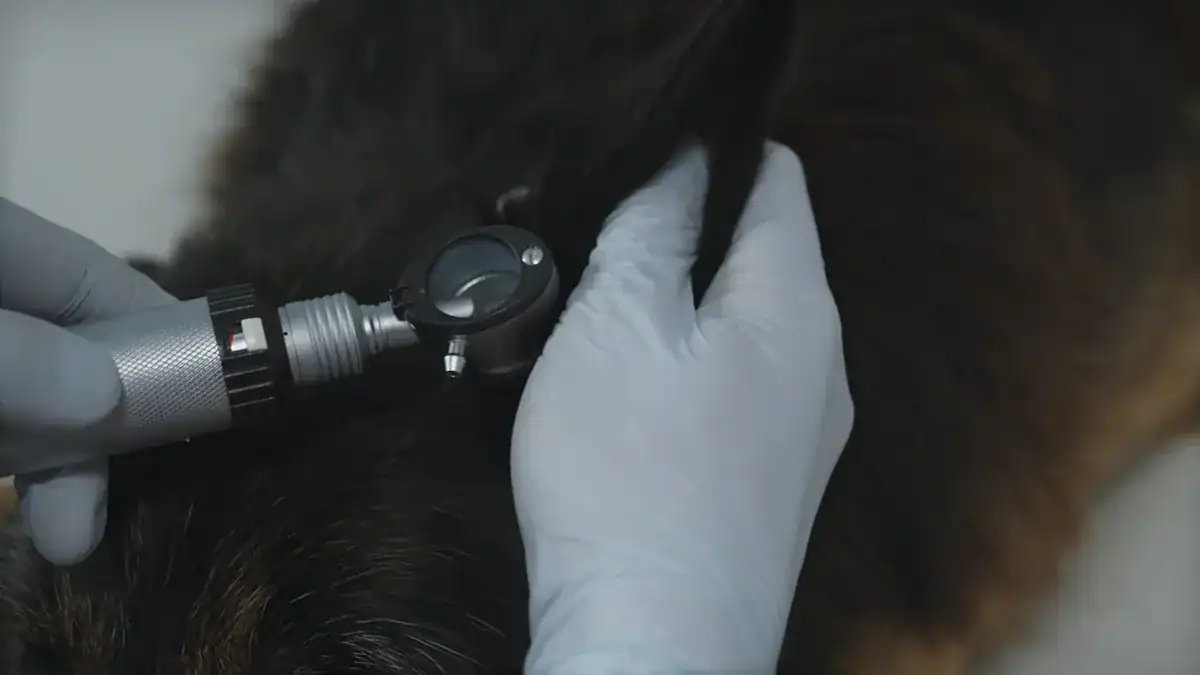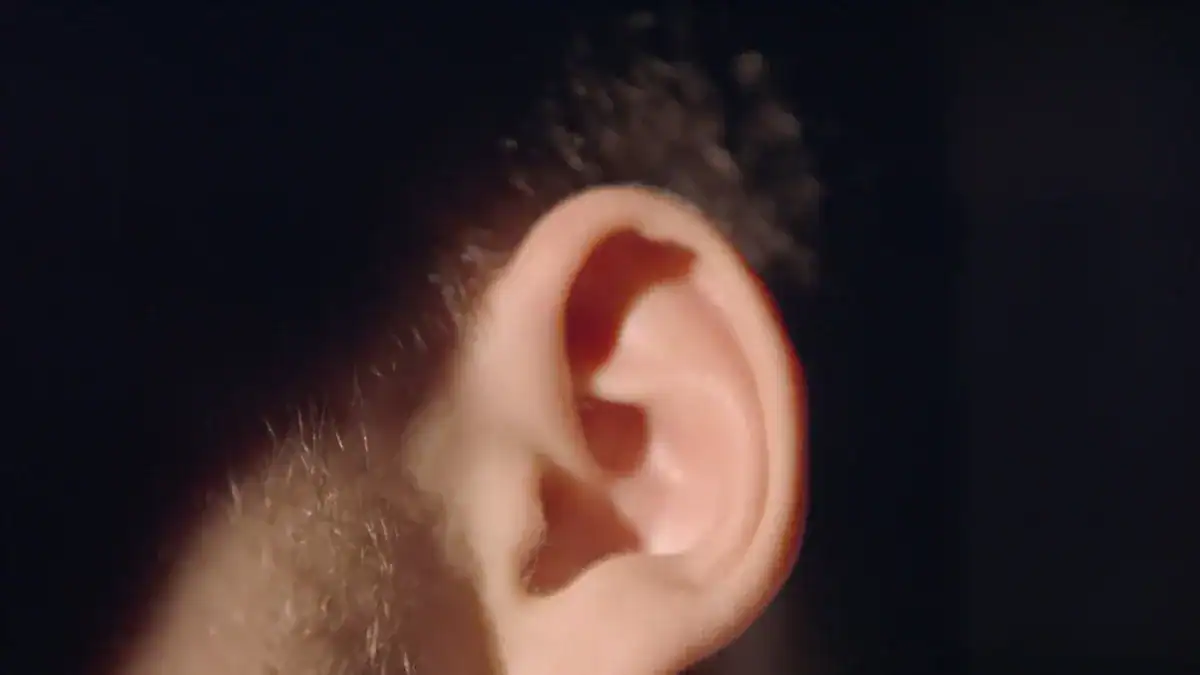
Fluid behind your eardrum, also known as serous otitis media or middle ear effusion, isn’t just a childhood ailment; it affects adults too. In fact, one study revealed that approximately 3.2% of adults experience this issue.
You might be concerned about potential hearing loss or discomfort in your ear. Even if it seems painless, this condition can be serious. It’s crucial to understand the causes and symptoms of fluid behind the eardrum.
Key Takeaways
Fluid behind the eardrum affects adults and can cause muffled hearing or pressure.
Many things cause fluid in the ear, like allergies, colds, and problems with your Eustachian tube.
See a doctor if you have ear pain, hearing loss, or dizziness to prevent bigger problems.
Treatments range from waiting to see if it clears up to medicines or surgery.
Manage allergies and avoid smoke to help stop fluid from coming back in your ear.
Fluid Behind Eardrum

What Is Middle Ear Effusion
Otitis media with effusion (OME) is a condition where you have fluid behind your eardrum. This fluid collects in the middle ear space. Doctors define OME as thick or sticky fluid behind the eardrum, occurring without an active middle-ear infection.
It is also known as the accumulation of semi-sterile secretion in the middle ear. This means you have fluid, but no active bacterial or viral infection is causing it. Sometimes people call this “glue ear” because the fluid can be very thick and sticky. This differs from an acute middle-ear infection, which involves active bacterial or viral presence.
Adult Versus Child Presentation
Fluid in the ear affects adults differently than children. Children often get fluid behind the eardrum because their Eustachian tubes are not fully developed. These tubes are shorter and more horizontal in children. The muscles that open the Eustachian tube also work less effectively in children.
This makes it harder for fluid to drain from their middle ear. Large adenoids in children can also block the Eustachian tube opening. In adults, the Eustachian tube is longer and steeper. Its cartilage is less dense, and the muscles open it more effectively.
While adults are less prone to this condition, it can still happen. When adults experience otitis media with effusion, the causes and implications can be more serious. You might not have an active ear infection, but the fluid still needs attention. Adults can also get a middle-ear infection, but OME is specifically about the fluid without that active infection.
Causes of Fluid in the Ear
Many factors can lead to fluid behind your eardrum. These causes often involve inflammation, mucus buildup, or structural problems. These issues block the natural drainage pathways in your ear. You need to understand these causes to address the problem effectively.
Eustachian Tube Dysfunction
Your Eustachian tube connects your middle ear to the back of your throat. It helps to equalize pressure and drain fluid from your middle ear. When this tube does not work correctly, you have Eustachian tube dysfunction. This is a primary cause of fluid accumulation in the middle ear. The tube’s inability to properly ventilate your middle ear leads to fluid buildup.
This fluid can be thin and watery (serous), thick and sticky (mucoid), or even contain blood or pus. This condition often results in middle ear effusions (MEE) and otitis media with effusion (OME). Fluid in the ear, also known as otitis media, occurs when inflammation or congestion obstructs the Eustachian tube.
This small drainage passageway becomes blocked. This blockage causes fluid to become trapped in your middle ear, behind your eardrum. This leads to symptoms like muffled hearing and ear pressure or pain.
Allergies And Sinus Issues
Allergies and sinus problems cause inflammation in your nasal passages and throat. This inflammation can extend to your Eustachian tubes. When your Eustachian tubes swell, they cannot open and close properly.
This prevents air from reaching your middle ear and stops fluid from draining. Common allergens associated with Eustachian tube inflammation and fluid behind the eardrum in adults include mold spores, tree pollen, and grass pollen.
Seasonal allergies, especially pollen allergies, also increase your risk of ear problems. They cause congestion and inflammation. This makes your ear more likely to hold fluid.
Upper Respiratory Infections
Colds, the flu, and other upper respiratory infections are common causes of fluid in the ear. These infections cause swelling and mucus production in your nose and throat. This swelling can block your Eustachian tubes.
When the tubes are blocked, air cannot enter your middle ear. This creates a vacuum that pulls fluid from the surrounding tissues into your middle ear space. The fluid then gets trapped. This can happen with viral, bacterial, or combined infections.
Middle-Ear Infection (Otitis Media)
An active middle-ear infection, also called acute otitis media, involves bacteria or viruses. This infection causes inflammation and pus to build up in your middle ear. This leads to fluid behind your eardrum.
You experience pain and fever with this type of ear infection. Even after the acute infection clears, fluid can remain in your middle ear for weeks or months. This lingering fluid is a form of otitis media with effusion. It is important to treat the initial middle-ear infection to prevent further complications.
Chronic Ear Infection
A chronic ear infection, or chronic otitis media, is a long-lasting infection or inflammation of the middle ear. A doctor diagnoses chronic suppurative otitis media when pus or skin-like material accumulates in a hole or pocket in your eardrum. This material often drains from your ear.
Doctors take samples of the ear discharge to identify the bacteria causing the infection. If they suspect a cholesteatoma, which is a skin growth in the middle ear, they may perform CT or MRI tests.
For persistent or recurrent granulation tissue on your eardrum, a biopsy may be conducted to check for tumors. This ongoing infection and inflammation keep fluid trapped in your ear.
Barotrauma
Barotrauma happens when there is a sudden change in air pressure. Your Eustachian tube cannot equalize the pressure in your middle ear quickly enough. This pressure imbalance can cause fluid to build up behind your eardrum. Ear barotrauma commonly results from pressure imbalances during activities such as scuba diving, air travel, hyperbaric oxygen therapy, or exposure to an explosive blast.
Specific pressure changes and activities that cause ear barotrauma include changes in altitude during airplane take-off or landing. Rapid altitude changes when you go quickly up or down a mountain also cause this. Scuba diving, where changes in water pressure affect your ear’s tympanic cavity, is another common cause.
Conditions that hinder Eustachian tube function, like colds, allergies, and sinus infections, make you more prone to barotrauma. These conditions cause swelling and mucus buildup, blocking your Eustachian tubes.
Nasal Obstructions
Physical blockages in your nasal passages can also affect your Eustachian tubes. These obstructions prevent proper airflow and drainage. This leads to fluid in the ear.
Examples of anatomical nasal obstructions include nasal polyps, cleft palate, and skull base tumors. Adenoid enlargement, especially in young children, can also block the Eustachian tube opening.
In adults, these obstructions can similarly impair Eustachian tube function. This creates an environment where fluid can easily accumulate in your middle ear.
Irritants And Smoking
Exposure to irritants, especially cigarette smoke, can cause inflammation in your respiratory system. This includes the lining of your Eustachian tubes. Smoking approximately doubles your risk of developing Obstructive Eustachian Tube Dysfunction (OETD).
Doctors diagnose OETD when your middle ear pressure is less than -100 daPa. OETD is a condition where your Eustachian tube fails to properly ventilate and balance pressure in your middle ear. This can lead to fluid accumulation behind your eardrum. Secondhand smoke also contributes to this inflammation. Avoiding these irritants helps keep your Eustachian tubes healthy and reduces the causes of fluid in the ear.
Symptoms in Adults
Fluid behind your eardrum can sometimes be painless. However, you should still take these symptoms seriously.
Muffled Hearing Or Loss
You might notice your hearing sounds muffled. It feels like you are listening underwater. This happens because the fluid behind your eardrum blocks sound waves. This blockage prevents them from reaching your inner ear properly. You may experience a partial loss of hearing. This makes it hard to understand conversations.
Ear Fullness Or Pressure
You often feel a sense of fullness or pressure in your ear. It feels like your ear is plugged. This sensation comes from the fluid buildup in your middle ear. The pressure can be constant. It might also change when you swallow or yawn.
Tinnitus
Some adults with fluid in the ear experience tinnitus. This means you hear ringing, buzzing, or hissing sounds in your ear. These sounds are not from an outside source.
Some people may experience ringing in the ears (tinnitus) or have balance problems due to dizziness or vertigo (the feeling like everything around you is spinning).
Dizziness Or Imbalance
Fluid in your ear can affect your balance. You might feel dizzy or unsteady. Some people experience vertigo. This makes you feel like everything around you is spinning. These symptoms can make daily activities difficult.
Mild Ear Discomfort
You might feel a mild ache or discomfort in your ear. This is usually not severe pain. It is more of a dull sensation. The discomfort comes from the pressure of the fluid. This pressure pushes against your eardrum.
When To Seek Medical Help
You should see a doctor if you notice any of these symptoms of fluid in the ear. Early diagnosis helps prevent complications. Seek medical help if you experience:
Ear pain, with or without fever.
Itching of the ear or ear canal.
Loss of hearing or difficulty hearing in one or both ears.
Pus or discharge from an ear, especially if it is thick, yellow, bloody, or foul-smelling.
Persistent ear pain that is not improving.
Fever accompanying ear pain.
Fluid draining from the ear.
Dizziness or vertigo.
Nausea or vomiting.
Sudden hearing loss.
Worsening symptoms.
Diagnosing Fluid Behind Eardrum

When you suspect you have fluid behind your eardrum, a doctor will perform several tests. These tests help confirm the presence of fluid and rule out other conditions.
Ear Examination
You need a doctor to look inside your ear. They use an otoscope. This tool helps them see your tympanic membrane. They look for specific signs of fluid. These signs include:
Opaque fluid
Air/fluid levels
Clear fluid
Bubbles
Retraction of the tympanic membrane
Slight bulging
Slight erythema (redness)
Prominent blood vessels
Hemorrhage
Amber or white fluid
Mild bulging
Tympanosclerosis (scarring)
Tympanometry
This test measures how your tympanic membrane moves. A tympanometer has a probe. This probe seals in your ear canal. It changes air pressure from negative to positive. It also sends a sound wave towards your tympanic membrane. A microphone records the sound energy reflected from it.
If your middle ear has fluid, most sound reflects back from a stiff tympanic membrane. If your middle ear is healthy and air-filled, the tympanic membrane absorbs energy. A flat tracing on the tympanogram often means fluid in your middle ear. This is especially true if your ear canal volume is normal.
Hearing Tests
Doctors use hearing tests to check your hearing. Tympanometry, as mentioned, assesses tympanic membrane movement. Other tests help identify conductive hearing loss. This type of hearing loss happens when sound cannot reach your inner ear.
The Weber and Rinne tests can tell if you have hearing loss in one ear. They also show if it is conductive or sensorineural. Otoacoustic emissions (OAEs) testing uses a small probe. It stimulates your cochlea. This test can find blockages or excess fluid in your middle ear. Bone conduction testing bypasses your outer and middle ear. It sends vibrations directly to your inner ear. This helps diagnose conductive hearing loss.
Imaging Studies
Sometimes, doctors need more detailed pictures. High-Resolution CT (HRCT) of the temporal bone is often the best choice for fluid behind eardrum. CT scans cannot tell the difference between fluid types.
Doctors consider MRI if they suspect other problems. These include issues in your nasopharynx or complications inside your skull. For children, doctors usually diagnose fluid with tympanometry. They only order CT scans if they suspect complications or if standard treatments do not work.
Treatment Options for Fluid in the Ear
When you have fluid in the ear, your treatment aims to drain the fluid and resolve any underlying issues. You have several options available, ranging from simply waiting to more active interventions.
Watchful Waiting
Sometimes, your doctor might suggest watchful waiting. This means you do not start immediate treatment.
Instead, you monitor your symptoms. Fluid in the ear often clears up on its own, especially if it is a recent occurrence. Your doctor will schedule follow-up appointments to check your ear. They will make sure the fluid is resolving. This approach is common when your symptoms are mild and not affecting your hearing significantly.
Autoinflation Techniques
You can try autoinflation techniques to help clear fluid from your ear. These methods help to open your Eustachian tubes. This allows air to enter your middle ear and fluid to drain.
Here is one way to perform an autoinflation technique:
Sit down or lie on your back.
Take a breath.
Push that breath out against your closed mouth and nose. Strain as if you are trying to have a bowel movement. Hold for 15 to 20 seconds.
Open your nose or mouth and breathe out.
You can also try the Valsalva maneuver:
Pinch your nose closed.
Close your mouth.
Try to exhale, as if inflating a balloon.
Bear down, as if having a bowel movement.
Do this for about 10 to 15 seconds.
This maneuver can help with problems like air temporarily blocking the Eustachian tube in your inner ear. This often happens during airplane takeoff or landing. It can help your ears ‘pop’ open by forcing air through your sinuses and Eustachian tube. An alternative method involves lying down and blowing into an empty syringe for 15 seconds.
Surgical Interventions
If fluid in the ear persists or causes significant problems, you might need surgery. Myringotomy with ventilation tubes is a common surgical treatment. This procedure involves making a small incision in your eardrum. Your surgeon then inserts a tiny tube. This tube helps to ventilate your middle ear and drain the fluid.
Doctors consider this surgery for several reasons:
Fluid in the ear (Otitis Media with Effusion – OME) lasting over 3 months with ongoing symptoms like aural pressure or hearing loss.
Recurrent acute ear infection (more than 3 episodes in 6 months or more than 4 in 12 months) with middle ear effusion.
Structural damage to your tympanic membrane or middle ear, such as cholesteatoma or chronic retraction.
Barotitis (barotrauma) that does not resolve.
Autophony caused by a patulous Eustachian tube.
Middle ear dysfunction resulting from head and neck radiation or skull base surgery.
Severe complications of an acute ear infection, such as meningitis, intracranial abscess, mastoiditis, or facial nerve paralysis.
Persistent acute ear infection despite at least two different courses of recommended antibiotic therapy.
To obtain a culture of middle ear fluid for diagnostic purposes, especially when an ear infection has not responded to antibiotics or in immunocompromised individuals.
Myringotomy with ventilation tubes significantly improved hearing outcomes in nasopharyngeal carcinoma patients after radiotherapy. This intervention also showed better outcomes compared to repeat myringotomies with aspiration in survivors of nasopharyngeal carcinoma.
Addressing Root Causes
Effective treatment for fluid in the ear also involves addressing the underlying causes. If allergies are contributing to your problem, managing them is crucial. This might involve allergy medications or avoiding triggers.
If nasal obstructions are present, your doctor might suggest treatments to clear them. For example, treating chronic sinus issues can prevent fluid from recurring. By tackling the root cause, you can reduce the chances of fluid building up in your ear again.
Preventing Fluid Recurrence
You can take several steps to stop fluid from returning to your ear. These actions help keep your Eustachian tubes clear and healthy. This reduces the chance of future problems.
Allergy Management
Managing your allergies is very important. Allergies cause inflammation and irritation in your ear. This leads to repeated issues with fluid in the ear. If you have ongoing allergy symptoms, consider allergy testing. Then, you can get proper treatment. Allergen Immunotherapy (AIT) helps your body build tolerance to allergens. This can significantly reduce or even eliminate symptoms.
Studies show AIT can resolve middle ear effusion in many patients. Medications like leukotriene antagonists, such as Montelukast, are also effective for allergic otitis media with effusion (OME). These drugs help prevent chronic OME and have few side effects.
Avoiding Irritants
You should avoid irritants that can inflame your Eustachian tubes. Cigarette smoke is a major irritant. It can cause inflammation in your respiratory system. This includes the lining of your Eustachian tubes. Do not smoke. Also, avoid secondhand smoke. This helps keep your Eustachian tubes healthy.
Cold And Sinus Care
Colds and sinus problems often block your Eustachian tube. This causes fluid to build up behind your eardrum. You can prevent colds by washing your hands regularly. Get recommended vaccines, like the flu vaccine. Avoid close contact with sick people. If you get a cold or sinus infection, a nasal rinse can help clear your sinuses. Drink plenty of fluids to loosen mucus.
Rest helps your body fight off infections. Daily saline nasal irrigation removes irritants and allergens. This reduces the risk of germs moving to your ear. Managing allergies with anti-allergy nasal sprays also prevents Eustachian tube swelling.
Pressure Equalization
Equalizing pressure is crucial during activities like flying or diving. This prevents fluid accumulation in your ear. Divers must practice equalization techniques regularly. This prevents middle ear barotrauma. This injury happens from pressure differences across your eardrum.
You can use several techniques. The Valsalva maneuver involves pinching your nose and gently blowing air out. The Frenzel maneuver uses your tongue to compress air. The Toynbee maneuver involves swallowing while holding your nose. Always descend slowly and pause often to equalize pressure. This ensures your ears equalize with the surrounding pressure.




